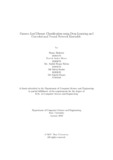| dc.contributor.advisor | Chakrabarty, Amitabha | |
| dc.contributor.author | Shahriar, Hasan | |
| dc.contributor.author | Shuvo, Protick Sarker | |
| dc.contributor.author | Fahim, Md. Saidul Haque | |
| dc.contributor.author | Sordar, Md Sobuj | |
| dc.contributor.author | Haque, Md Esadul | |
| dc.date.accessioned | 2022-05-18T04:18:38Z | |
| dc.date.available | 2022-05-18T04:18:38Z | |
| dc.date.copyright | 2022 | |
| dc.date.issued | 2022-01 | |
| dc.identifier.other | ID 20301476 | |
| dc.identifier.other | ID 16301078 | |
| dc.identifier.other | ID 16301053 | |
| dc.identifier.other | ID 17301148 | |
| dc.identifier.other | ID 16201032 | |
| dc.identifier.uri | http://hdl.handle.net/10361/16633 | |
| dc.description | This thesis is submitted in partial fulfillment of the requirements for the degree of Bachelor of Science in Computer Science and Engineering, 2022. | en_US |
| dc.description | Cataloged from PDF version of thesis. | |
| dc.description | Includes bibliographical references (pages 32-35). | |
| dc.description.abstract | Cassava is a high-protein and nutrient-dense plant, notably inside the leaves. Cassava
is often used as a rice alternative. Pests, viruses, bacteria, and fungus may cause
a variety of illnesses on cassava leaves. This study consists of four main diseases that
commonly affect cassava leaves: Cassava Bacterial Blight (CBB), Cassava Brown
Streak Disease (CBSD), Cassava Green Mite (CGM), and Cassava Mosaic Disease
(CMD) and we took these four diseases as labels in our research. Furthermore, we
took 22000 infected images from Kaggle and we have transformed our dataset into
four different image transformation to ensure the accuracy of our model. These
four different augmentations are Random Crop Augmentation, Random Flip Augmentation,
Random Rotation Augmentation and Random Contrast Augmentation.
Finally, we used six algorithms to detect the diseases of cassava leaves. These six algorithms
are Xception, EfficientNetB0 Resnet50, VGG16 Densenet121, InceptionV3.
While we operated these algorithms on our trained dataset, it gave diverse precision.
For the Xception, it gave 91.3% accuracy, EfficientNetB0:91.1%, ResNet50: 85.0 %,
VGG16: 68.0 %, DenseNet121: 87.0 % and for the InceptionV3, it gave 86.4 % precision
respectively. Here, not every one of the algorithms performed well. Xception
and EfficientNetB0 have the most noteworthy accuracy among these. | en_US |
| dc.description.statementofresponsibility | Hasan Shahriar | |
| dc.description.statementofresponsibility | Protick Sarker Shuvo | |
| dc.description.statementofresponsibility | Md. Saidul Haque Fahim | |
| dc.description.statementofresponsibility | Md Sobuj Sordar | |
| dc.description.statementofresponsibility | Md Esadul Haque | |
| dc.format.extent | 35 pages | |
| dc.language.iso | en | en_US |
| dc.publisher | Brac University | en_US |
| dc.rights | Brac University theses are protected by copyright. They may be viewed from this source for any purpose, but reproduction or distribution in any format is prohibited without written permission. | |
| dc.subject | Deep learning | en_US |
| dc.subject | Cassava leaf | en_US |
| dc.subject | Prediction | en_US |
| dc.subject | Decision tree | en_US |
| dc.subject | Xception | en_US |
| dc.subject | Neural networks | en_US |
| dc.subject | EfficientNet B0 | en_US |
| dc.subject | Resnet 50 | en_US |
| dc.subject | VGG16 | en_US |
| dc.subject | Inception V3 | en_US |
| dc.subject | DenseNet 121 | en_US |
| dc.subject.lcsh | Machine learning | |
| dc.subject.lcsh | Cognitive learning theory (Deep learning) | |
| dc.subject.lcsh | Neural networks (Computer science) | |
| dc.title | Cassava leaf disease classification using deep learning and convolutional neural network ensemble | en_US |
| dc.type | Thesis | en_US |
| dc.contributor.department | Department of Computer Science and Engineering, Brac University | |
| dc.description.degree | B. Computer Science | |

